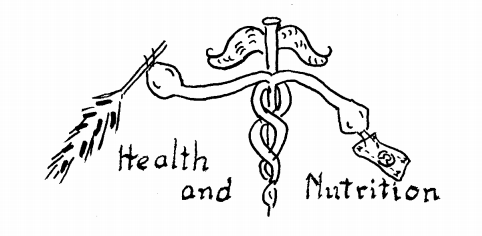This essay is reproduced here as it appeared in the print edition of the original Science for the People magazine. These web-formatted archives are preserved complete with typographical errors and available for reference and educational and activist use. Scanned PDFs of the back issues can be browsed by headline at the website for the 2014 SftP conference held at UMass-Amherst. For more information or to support the project, email sftp.publishing@gmail.com
Health and Nutrition: What You Don’t Know Can Harm You. What You Do Know Can Harm You.
by Brenda Lansdown (with the Health and Nutrition Column Collective)
‘Science for the People’ Vol. 6, No. 5, September 1974, p. 21
 Can you read print smaller than that in the telephone directory? This is the type the food industry uses to inform us of the additives in food.
Can you read print smaller than that in the telephone directory? This is the type the food industry uses to inform us of the additives in food.
Suppose we can and do read the small print, what does it tell us? Carrageenan, glycol monostearate, BHT, diglycerides, propylene glycol alginate! Most of us are none the wiser. Although It was a great triumph when consumer pressure forced the Federal Drug Administration (FDA) to require listing of non-foods on food packages, it really left the next step up to us. Do we spend our money on fresheners (which some wag said make the life of bread longer than that of the consumer), on antioxidants which prevent a rancid taste in old fats, on coloring matter which pleases the eye but may induce cancer, and on chemicals which give bulk to our ice cream (bought by the volume)? Or, do we organize a boycott of foods containing additives?
The FDA has ruled that additives must improve the nutritional value of the food, enhance consumer acceptability, improve the keeping quality, or facilitate preparation of the food. Furthermore, the Delaney Amendment states that a food additive which causes tumors in humans or animals must be banned. The FDA is charged with monitoring the harmful effects of the additives. Here’s the rub. There is a long list of additives which are classified as GRAS (Generally Regarded As Safe). Many of these permitted additives are nevertheless under further study because there is a suspicion that they may cause cancer (are carcinogens), produce mutations in the unborn (are mutagens), produce malformed babies (are teratogens), or have harmful effects on the nervous system. One or more of these effects are suspected to be caused by gum tragacanth, which is used in salad dressing and sherbert (but which has been banned in Great Britain, Romania and Sweden); by BHT, which one finds listed on our cereal boxes, freeze dried meat, candy and chewing gum wrappers; by various forms of glycerides which are common in beverages, ice cream, chocolate and whipped toppings, to name only a few.
When one knows the potential dangers of these additives, one does have the choice not to buy them. However, the dairy and baking industries have gained the “privilege” of not listing additives in their products. Ice cream may contain as many as thirty chemical additives and is lucky if it has ever seen a cow. Calcium sulphate (a form of Plaster of Paris) is often added to cottage cheese. A package labeled simply “bread:’ can contain bleaching and aging agents, dough conditioners and an incredible abundance of other chemicals.
A classic story is that of sodium nitrite which until recently was not listed on food labels. Sodium nitrite has long been a valuable chemical to the meat and fish industries. It enhances the color of hot dogs and other sausages and it kills Clostridium botulinum, a bacterium which causes the often fatal disease botulism. Thereby the nitrite increases the shelf life of cured meats, which allows large corporations to distribute on a national scale. Nitrites also impart the characteristic taste to ham and smoked fish… all within the FDA rulings. But… recently, nitrites have been found to produce cancer. They do this by combining with amines (a large class of organic compounds widely present in natural foods) to form nitrosamines. Various nitrosamines induce malignant tumors in mice, rats, dog, mink and sheep among many other mammals. They must be assumed to do so also in humans.
When the U.S. Department of Agriculture (USDA) was challenged to ban nitrites from the meat and fish industries it claimed that the original objective was eye and taste appeal. When asked about the cancer danger, the USDA said that botulism would be rampant if nitrites were not used.
There exist several ways out of this dilemma. Botulinum bacteria are killed when heated to 180° for thirty minutes, or kept under continuous freezing conditions. Large quantities of Vitamin C have been found to block most of the nitrite from joining with the amines. So if you have the time to search, and if you can accustom your eye to a grayish hot dog and a slightly different taste, there are food co-ops and the Shiloh Farms which market frozen additive-free cured meats.
There’s a lot more to this story, and we suggest that you may want to inform yourselves by reading the listed books. Those of us who know, must tell others. It is critical that we also bring pressure by writing congress-people and the Commissioner of FDA (Rockville, Maryland 20852) to have nitrites totally banned immediately and to have additives listed on dairy and bakery goods.
In the meantime, shop carefully and do read the small print!
How Sodium Nitrite Can Affect Your Health, Michael F. Jacobson, Center for Science in the Public Interest, 1779 Church Street, NW Washington, DC 20036 (1973).
A Consumer’s Dictionary of Food Additives, Ruth Winter, N.Y. Crown (1972).

